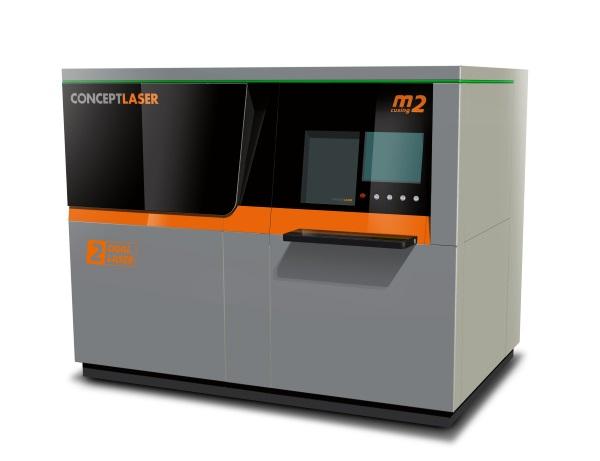Reaction Systems Wins Two-Year, $750K SBIR Contract Extension Thanks to Additive Manufacturing Expertise from ADAPT Consortium and Faustson Tool
 The Alliance for the Development of Additive Processing Technologies (ADAPT), a research and development consortium based out of Colorado that’s dedicated to developing advanced additive manufacturing technologies, gives a leg up to all of its member companies, including recently added member Sinter Print and Concept Laser, the first manufacturer of 3D metal printers to join the consortium. There are several buy-in levels of membership, including Tier 2, where entities can access the ADAPT database, and Tiers 3 and up, where they have license to direct the center’s research activities. ADAPT member company Reaction Systems, which creates new products and processes and turns them into commercial products (like a membrane that separates carbon dioxide from a spacesuit environment), won a contract extension for their latest project, after they reached out to ADAPT and founding consortium member Faustson Tool for some additive manufacturing assistance.
The Alliance for the Development of Additive Processing Technologies (ADAPT), a research and development consortium based out of Colorado that’s dedicated to developing advanced additive manufacturing technologies, gives a leg up to all of its member companies, including recently added member Sinter Print and Concept Laser, the first manufacturer of 3D metal printers to join the consortium. There are several buy-in levels of membership, including Tier 2, where entities can access the ADAPT database, and Tiers 3 and up, where they have license to direct the center’s research activities. ADAPT member company Reaction Systems, which creates new products and processes and turns them into commercial products (like a membrane that separates carbon dioxide from a spacesuit environment), won a contract extension for their latest project, after they reached out to ADAPT and founding consortium member Faustson Tool for some additive manufacturing assistance.
 Reaction Systems, which is also in Colorado, was working on developing a hypersonic jet engine part for a Phase II Small Business Innovation Research (SBIR) project with the Air Force Research Laboratory (AFRL), and soon realized they were in need of some expert specialized additive manufacturing help – they needed to create a prototype of the part in order to keep the project moving forward. ADAPT, and its additive materials characterization center, are both headquartered at the Colorado School of Mines, which was awarded $2.5 million last year to study 3D metal printing; they pointed Reaction Systems in the right direction.
Reaction Systems, which is also in Colorado, was working on developing a hypersonic jet engine part for a Phase II Small Business Innovation Research (SBIR) project with the Air Force Research Laboratory (AFRL), and soon realized they were in need of some expert specialized additive manufacturing help – they needed to create a prototype of the part in order to keep the project moving forward. ADAPT, and its additive materials characterization center, are both headquartered at the Colorado School of Mines, which was awarded $2.5 million last year to study 3D metal printing; they pointed Reaction Systems in the right direction.
Jeff Engel, Reaction Systems’ COO, said, “We had no experience with additive manufacturing, and started looking around to find the expertise and resources we needed. A contact at Mines connected us with founding member Faustson and ADAPT. That enabled us to quickly manufacture the part with the internal geometry it requires, something we could not have done with traditional machining techniques.”
Real-time additive manufacturing monitoring costs hundreds of thousands of dollars, and smaller manufacturers, like Reaction Systems, just can’t justify the kind of expense necessary to adopt the technology in their own facility. With a membership to the ADAPT consortium, these smaller manufacturers have access to shared resources, expertise, and peer organizations offering complementary needs and services, all of which makes it much more affordable for companies like Reaction Systems and Faustson to invest in additive manufacturing, and use the emerging technology to complete their own projects.
“The part has an intricate interior channel that can only be made this way. As it moves forward, our production volume will grow, and we’ll need ADAPT’s expertise to show the part can withstand rigorous conditions,” explained David Wickham, Reaction Systems’ president and senior project manager, about their SBIR project. “They’ve already demonstrated they can provide useful data to help us do that, and membership helps us expand our capabilities and expertise in using catalysts on complex surfaces.”
 Faustson worked with Reaction Systems to make the part in just a few days, using its Concept Laser machine. The Mines research and development team used ADAPT lab equipment to characterize the part, and show that it met design specifications.
Faustson worked with Reaction Systems to make the part in just a few days, using its Concept Laser machine. The Mines research and development team used ADAPT lab equipment to characterize the part, and show that it met design specifications.
“AFRL was right when when they asked it to be made additively,” said Heidi Hostetter, ADAPT Industry Board Chair and Faustson Vice President. “A complex part, accelerated schedule, and low volume was tailor-made for 3D metal printing.”
The certification of the 3D printed prototype was a success. Thanks to this valuable collaboration between ADAPT members, the Reaction Systems SBIR project contract, worth $750,000, has been extended for two years, so they can continue to work on the part. Most of Reaction Systems’ work in developing leading-edge technologies is done through the SBIR program, by conducting research, cultivating commercialization partners, and securing patents. For example, the company invented a way to map and remove carbon deposits, or coke, in order to improve the performance of rocket engines. With ADAPT on their side, they will be able to take on even more projects that would be nearly impossible without additive manufacturing. Discuss in the ADAPT forum at 3DPB.com.
Subscribe to Our Email Newsletter
Stay up-to-date on all the latest news from the 3D printing industry and receive information and offers from third party vendors.
You May Also Like
3D Printing Financials: Fathom Struggles in Financial Quicksand During Critical Transition
Facing a year of key transitions and financial pressures, Fathom (Nasdaq: FTHM) has filed its annual report for 2023 with the U.S. Securities and Exchange Commission (SEC). The document outlines...
Latest Earnings Overview for Australian 3D Printing Firms Titomic and AML3D
Australian 3D printing manufacturing firms Titomic (ASX: TTT) and AML3D (ASX: AL3) reported their financial results for the period from July to December 2023, marking the first half of their...
3D Printing Webinar and Event Roundup: April 7, 2024
Webinars and events in the 3D printing industry are picking back up this week! Sea-Air-Space is coming to Maryland, and SAE International is sponsoring a 3D Systems webinar about 3D...
3D Printing Financials: Unpacking Farsoon and BLT’s 2023 Performance
In the Chinese 3D printing industry, two companies, Farsoon (SHA: 688433) and Bright Laser Technologies, or BLT (SHA: 688333), have recently unveiled their full-year earnings for 2023. Farsoon reported increases...































